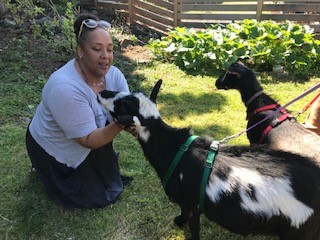
9/3/2020
An interview with Suzanne Righi, Seattle Public School teacher and Arts Impact participant
What’s your Arts Impact story? How did you first get involved?
I was reluctant… more than reluctant, I was very unhappy. When I was teaching at Madrona, the program was required. We were told to be there, and this was 30 hours of my life that I would never get back. I was mad. I didn’t want to do it. I felt like it was just one more “thing” that would come and go. I found out it was a 2-year commitment, and that didn’t help. It was also definitely out of my comfort zone. I didn’t consider myself an artist. I certainly was not interested in doing dance with anybody.
Slowly, I really enjoyed the sessions with Carol [Gould] for visual arts, and that softened my outlook. The first year went well, but knowing that I would have to do movement, dance, and theatre the next year I was still kind of reluctant. However, the other thing that made a difference was engaging with Bev (Beverly Harding Buehler, current Executive Director) around any issues that came up. She was always willing to have those conversations.
The next year, I dropped down into third grade, and I had Dave [Quicksall], who was very chill, and we had to work some stuff out. I needed my students to understand that this was important and not just for fun, and eventually they got it together. And Dave was willing to flex with some things—so again, the ability to have conversation and then be flexible made a huge difference.
And then I had this big moment. We were doing a multi-dimensional art exercise with beads, and this one little guy said, “Miss Righi, this is just like multiplication!” and it was just a big ah-ha moment. One thing I’ve figured out in my own teaching is that it’s one thing to teach theory or content or whatever, but what matters is the experience you give students to solidify the learning. That’s what Arts Impact did in that moment, and does for me still. Arts Impact allows adults to see the brilliance of children.
I’ve been hooked ever since.
How have you participated through the years?
I beg, plead, and ask to go to every training, even after Seattle stopped participating. I’ve also presented with Beverly in Florida at a conference. It’s a skill, so if you stop using it, you lose it. What’s important is the strategy. You think, ok—this isn’t sticking, what do I do? Well, let me pull out the character map that I did with Dave around Mr. Fox; let’s practice emotions, or whatever.
You participated in the virtual institute recently– tell me about why you decided to do this now and what you got from it.
I hadn’t gone to the Institute the year before, and that was the first year I hadn’t gone. The thing that I realized, was that this experience also prepares me to go into school. It’s my reprieve before the end of summer and before the school year starts, and it really does just fill my bucket and get me back into a “kids first” mindset. How can I integrate this into what I’m doing? Even without access to the field trips and mentorships, how can I bring this experience to my kids.
I thought the virtual institute was really good, and I was surprised. I felt like it was exactly what I needed. I needed to see it, and then I realized that I can do those things with my own class.
Is there anything else you’d like to share?
Any time you’re dealing with Title schools, you’re dealing with high turnover, transient populations… so I think building teacher capacity is the most important thing. It’s not that it’s not about kids, but it’s absolutely about building capacity in adults, who will pass that on to them in the classroom.
Want more stories like this? Join our list for artistic inspiration, professional development opportunities, resources, and success stories of arts integrated teaching and learning—right in your inbox!